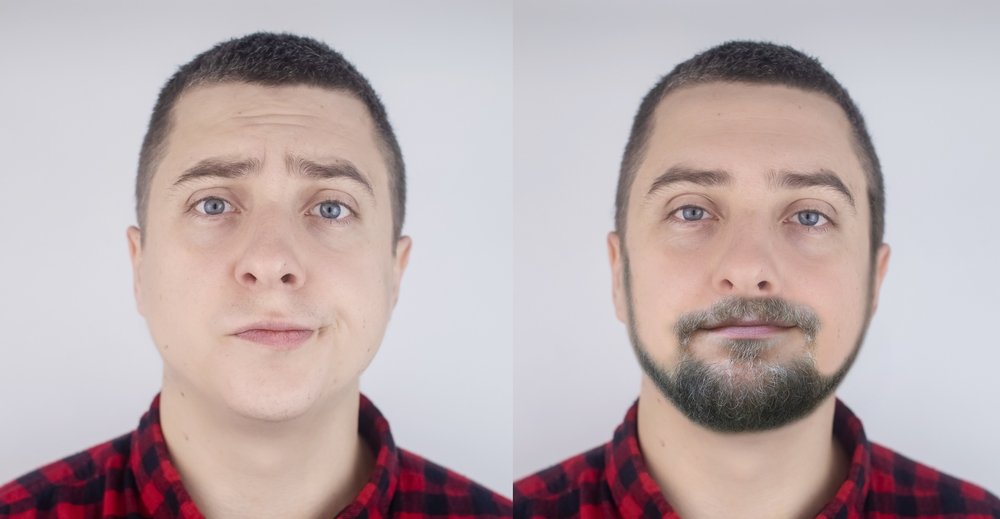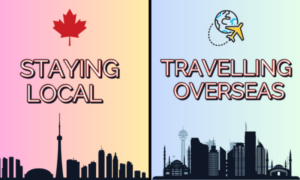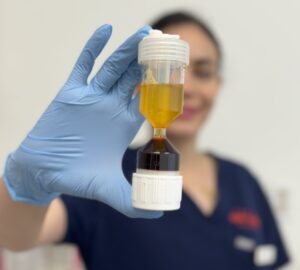Many people who want a fuller and thicker beard or mustache often try different methods and products. Minoxidil has become a popular choice among these. Minoxidil, also known as Rogaine, is effective in promoting hair growth, mainly on the scalp.
However, its use for facial hair growth has gained increasing attention in recent years. In this article, we will dive into the world of minoxidil for beard and facial hair growth, exploring its benefits, usage, potential side effects, and more.
Minoxidil for Beard & Mustache Growth
Minoxidil was initially formulated to address hypertension and garnered attention for its surprising secondary effect: promoting hair growth. This unexpected discovery prompted researchers to investigate its potential for treating diverse forms of hair loss, notably male pattern baldness.
As studies progressed, anecdotal evidence suggested minoxidil’s efficacy in stimulating facial hair growth. Users experimenting with the solution observed significant improvements, especially in areas previously lacking substantial growth.
This revelation sparked widespread interest and experimentation among individuals seeking to enhance their beard and mustache density. This led to its growing popularity as a viable solution for facial hair growth augmentation.
Beard Growth Stages & Minoxidil
Understanding the stages of beard growth is crucial for comprehending how minoxidil works in this context. The beard growth cycle consists of three phases:
Anagen Phase (Growth Phase):
During the anagen phase, the beard follicles are in a state of active growth, continuously producing new hair cells. Minoxidil plays a pivotal role in this phase by extending its duration. By prolonging the anagen phase, minoxidil ensures that hair follicles have more time to grow and mature, resulting in denser and fuller beard growth over time.
Catagen Phase (Transitional Phase):
The catagen phase marks a transitional period in the beard growth cycle. During this phase, the hair follicles undergo a regression, halting the production of new hair cells. While minoxidil primarily targets the anagen phase, its influence may indirectly affect the catagen phase by promoting healthier follicles and minimizing hair shedding, ensuring a smoother transition to the next growth phase.
Telogen Phase (Resting Phase):
In the telogen phase, the beard follicles enter a dormant state, ceasing active growth. Existing hairs may shed to make room for new growth during this resting period. While minoxidil’s direct impact on the telogen phase is limited, its ability to extend the anagen phase indirectly affects this stage by facilitating a more robust and consistent growth cycle.
By promoting prolonged growth, minoxidil helps maximize the potential for thicker, fuller beard growth during subsequent cycles.
Who Can Use Minoxidil?
Minoxidil is generally safe for use by adult men seeking to enhance their facial hair. While primarily marketed towards individuals experiencing male pattern baldness (expressly targeting the scalp/head), it has been embraced by those aiming to bolster their beard or mustache.
However, it’s crucial to seek advice from a healthcare professional before initiating any new hair growth regimen, particularly if you have underlying health conditions or are currently taking any medications.
How to Use Minoxidil for Facial Hair Growth?
Achieving optimal results with minoxidil for facial hair growth necessitates a disciplined approach and steadfast consistency. By adhering to a systematic application routine, individuals can maximize the effectiveness of minoxidil in promoting beard and mustache growth.
Let’s explore the step-by-step process of using minoxidil for facial hair growth to unlock its full potential.
Cleanse Thoroughly:
Start by washing your face with a mild facial cleanser to eliminate any dirt, oil, or impurities that could hinder minoxidil absorption. Gently pat your face dry with a clean towel to ensure it is clean and free of excess moisture before applying the product.
Determine Recommended Dosage:
Consult the product packaging or consult your healthcare provider to establish the appropriate dosage of minoxidil for stimulating facial hair growth. Dosages can differ based on the concentration of minoxidil and individual factors like hair density and skin sensitivity.
Apply Minoxidil to Desired Areas:
Using a dropper or foam applicator, dispense the prescribed amount of minoxidil onto your fingertips or directly onto the areas of the beard or mustache where you wish to stimulate growth. Make sure to apply the solution evenly across the intended areas, ensuring thorough coverage of any sparse or patchy growth areas.
Massage Gently Into the Skin:
Using clean hands, softly massage the minoxidil solution into the skin using circular motions. This massage action helps to promote absorption and ensures that the minoxidil reaches the hair follicles effectively.
Allow Time for Absorption:
After applying minoxidil, give it ample time to be absorbed into the skin and hair follicles. Refrain from touching or washing the treated areas immediately after application to allow the minoxidil to work without interference.
Follow the Manufacturer’s Instructions:
It’s crucial to follow the manufacturer’s instructions carefully to achieve optimal results and minimize the risk of adverse effects. Pay attention to recommended application frequency, duration, and any additional precautions or warnings provided.
By following these steps diligently and incorporating minoxidil into your daily grooming routine, you can maximize its effectiveness in promoting facial hair growth.
Consistency is key, so stick to your prescribed regimen and be patient as you journey to a fuller, thicker beard or mustache with minoxidil.
How Long Does It Take to See a Fuller Beard?
Patience is key when embarking on a minoxidil-based beard growth journey. While individual results may vary, noticeable improvements are typically seen within a few weeks to months of consistent use. However, it’s vital to manage expectations and understand that significant growth may take several months to become apparent. Consistency and patience are critical and mandatory.
Minoxidil for Beard Results
The results of using minoxidil for beard growth can be transformative for many individuals. With regular application, users often report denser, thicker facial hair, filling in patchy areas and achieving a more uniform appearance. These results can instill a newfound sense of confidence and satisfaction in one’s appearance.
Minoxidil Beard Side Effects
While generally well-tolerated, minoxidil may cause side effects in some users. Common side effects include:
Skin Irritation:
It is a common side effect of minoxidil. Users may experience redness, burning, or stinging sensations shortly after applying minoxidil to the beard or mustache. This irritation typically subsides over time as the skin becomes accustomed to the medication.
Dryness:
Dryness may occur following minoxidil application. Users may experience flakiness or tightness in the treated area. To alleviate dryness, moisturize the skin with a gentle, non-comedogenic moisturizer.
Itching:
Itching at the application site is another common side effect of minoxidil. Users may experience mild to moderate itching shortly after applying the solution. Refrain from scratching or rubbing the treated area to avoid worsening the itching sensation.
Allergic Dermatitis:
In rare cases, individuals may develop allergic dermatitis as a reaction to minoxidil. Symptoms may include severe itching, redness, swelling, and the formation of blisters or hives. If allergic dermatitis occurs, discontinue minoxidil use immediately and seek medical attention.
Unwanted Facial Hair Growth:
While minoxidil is intended to stimulate beard and mustache growth, it may inadvertently lead to hair growth in unintended areas. Some users may notice increased hair growth on the cheeks, forehead, or other parts of the face. If unwanted facial hair growth occurs, discontinuing minoxidil use typically resolves the issue over time.
It’s essential to monitor for any signs of side effects while using minoxidil for beard growth and to discontinue use if adverse reactions occur. Consulting a healthcare professional can guide managing side effects and determining the most appropriate course of action.
Is Minoxidil Prescribed for Beard Growth by Doctors?
While minoxidil is available over the counter for the treatment of hair loss, its use for facial hair growth may not be explicitly endorsed by all healthcare professionals.
Some doctors may prescribe it off-label for this purpose, especially for individuals with particular concerns about their beard or mustache.
However, it’s vital to seek medical advice before starting any new hair growth regimen.
Conclusion
In conclusion, minoxidil offers a promising solution for individuals seeking to enhance their beard or mustache. With its ability to extend the growth phase of hair follicles, minoxidil can facilitate the development of thicker, fuller facial hair over time.
However, it’s essential to use it responsibly, following the recommended guidelines and consulting with a healthcare professional if any concerns arise. By adding minoxidil to your grooming routine, you can discover the key to a more confident and vibrant beard.











